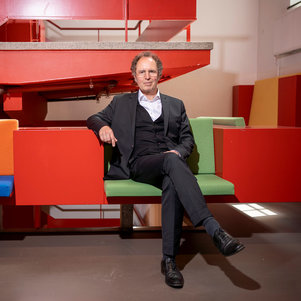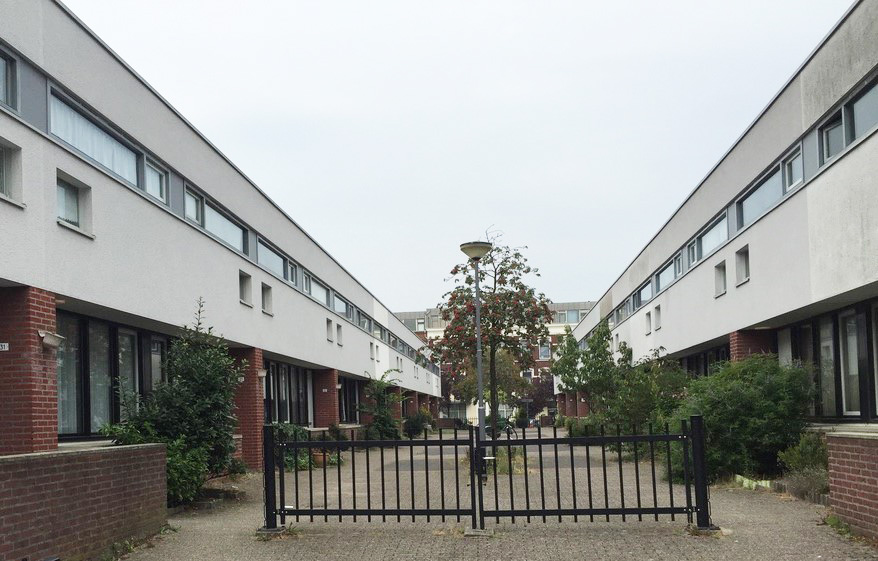A healthy city is a city that fosters a sense of connection
How do you design cities in such a way as to allow people to live as pleasurably and healthily as possible? Professor Machiel van Dorst combines his knowledge of architecture with a background in environmental psychology. For his inaugural address, Van Dorst argues for focusing on the city at eye level: “To a certain extent, where you live determines who you are.”
Increasingly, there is a focus on cities being ‘healthy’ or ‘sustainable’. Yet it is not quite clear what this entails. "It is important for people to experience a sense of control over their lives," says Prof. Machiel van Dorst. "This is about, for example, whether you can choose to retreat to a quiet space to work, or whether there are places where you can meet others. The physical environment facilitates that control. If something goes wrong here, feelings of insecurity or loneliness may arise. This in turn can result in a lack of exercise because people are reluctant to venture out into the neighbourhood. Or they take the car more often, which makes the street even more impersonal and unsafe. You end up in a vicious circle.”

Machiel van Dorst
It is important for people to experience a sense of control over their lives.
Machiel van Dorst
Multidisciplinary
You can influence that sense of control with urban design. Van Dorst’s research centres on how best to do that. As professor in Environmental Behaviour and Design, his work falls under the Urban Studies research group. “This is a transdisciplinary field par excellence. Researchers from social geography, urban sociology, data science, environmental psychology and co-creation all work here." This multidisciplinarity is exactly what is needed, Van Dorst believes. In science, but also beyond it: "Efficiency has been a key concept for far too long. The physical domain and welfare were two separate policy areas. Due to this specialisation, however, the people working in and on the same physical environment do not know one another."
A multidisciplinary approach is needed to be able to address various societal challenges. An unhealthy or unsafe living environment makes it more likely for people to become lonely or poor. Or to get too little exercise, for example. "My field is about spatial design as well as psychology," says Van Dorst. "There is a big behavioural component to it. Why do people travel by car instead of cycling? Or why don't people get together? By changing the environment, you can nudge people into making healthier choices."
By changing the environment, you can nudge people into making healthier choices.
Machiel van Dorst
Connection with the neighbourhood
Looking at a city or neighbourhood through a design lens, you can choose what to focus on. Is the city pleasant to live in, to work in, or is it attractive to visitors? According to Van Dorst, cities and neighbourhoods are often viewed from a far too instrumental point of view: “The focus is on people passing through and on visitors far too much, and there is too little attention for society as it plays out at eye level, in other words, the quality of the area as an environment to live and spend time in. Whereas by organising physical space, you can give people a sense of connection with a place. Unfortunately, far too often still, the neighbourhood tends to be the final aspect to be considered in the design; the primary considerations often are major traffic structures, access and mobility. Thus, visitors’ needs are better catered for than those of residents.” In the past, too, we tended to think about public space in overly simple terms: "The idea was: public space belongs to everyone. But that also means it belongs to no one and no one feels responsible. This happens especially in places with many high-rise buildings, where the public space becomes anonymous. You don't like to let your children play outside in a place like this."
The city at eye level
Fortunately, when it comes to health, there is an increasing shift from cure to prevention. Van Dorst: "We simply cannot afford all the care everyone needs anymore. Preventive health means, for example, being able to play in the street, living healthily and safely at home for longer, or being able to go out easily by oneself. These are all things that happen at the scale of the neighbourhood or district.” A healthy city, therefore, is a social city above all else, Van Dorst believes: "For example, there is more social interaction in a cul-de-sac or around a courtyard. Also, if there are front gardens, people feel safer, and are more inclined to have a chat with their neighbours."
Van Dorst's inaugural address is exactly about that sense of connection with your surroundings. ‘The city at eye level’ is what he calls it. “Design allows you to organise a neighbourhood in such a way that people can quickly 'read' the environment. For example, that they can read from the buildings that a block forms a neighbourhood - of which as residents they are co-owners, and to which as visitors they are welcome. In an environment like this, people feel responsible and also dare to turn to and address each other, for example for help or if there is rubbish on the street, or if a bicycle is stolen."
A healthy city is a social city more above all else.
Machiel van Dorst
Getting used to change
Measures that make a neighbourhood more social or healthier do sometimes meet resistance. "Everyone likes being able to park in front of their home. But people also want their children to be able to play outside safely. I am involved in the IJburg quality team in Amsterdam. There, the community has decided to have parking hubs - you walk the short distance from the hub to your home. This arrangement adds enormously to the spatial quality of the neighbourhood. People tend to have trouble with behavioural changes, though. That is why it is important to show residents that an arrangement like this works." And this aspect, getting people to own the process, is indispensable: “Many health-related measures also improve the liveability of a neighbourhood. Show people that this is true! For example, I have supervised PhD candidates in research on microclimates. Especially in urban areas, many people are already dying from the effects of excessive heat. Obvious measures to address this involve planting more greenery along streets. This makes for a more pleasant environment for walking, which is good for social cohesion, and so on. The solutions often end up being a combination of solutions."
Additionally, for an initiative to succeed it is important to give residents direction. “This can be done by awarding them a budget and allowing them to determine together how they wish to improve their neighbourhood. This is only possible if local residents not only work well together amongst themselves, but also with the municipality, for example." However, the municipality and other authorities still tend to regard the matter in far too abstract a manner. "For example, they use data on life expectancy or incomes based on tightly defined neighbourhoods. But often that is not at all how people actually perceive their neighbourhood."
Greater focus on the neighbourhood
Fortunately, Van Dorst sees a lot of curiosity among students about the user perspective of design. "They want to work on loneliness among the elderly or designs focused on child-friendliness." Van Dorst hopes that politicians also recognise the importance of the neighbourhood: "When you introduce yourself to someone, you probably mention spatial characteristics early on: 'I'm from... I live in...' Because you have a sense of connection with the space around you. Hence it is important for both designers and policymakers to pay more attention to that human scale in urban design."
More information
- Machiel van Dorst gave his inaugural address ‘Welkom in mijn buurt’ (‘Welcome to my neighbourhood’) on Friday 23 February. You can rewatch the inaugural address here.
- View Machiel's professor's page here.


